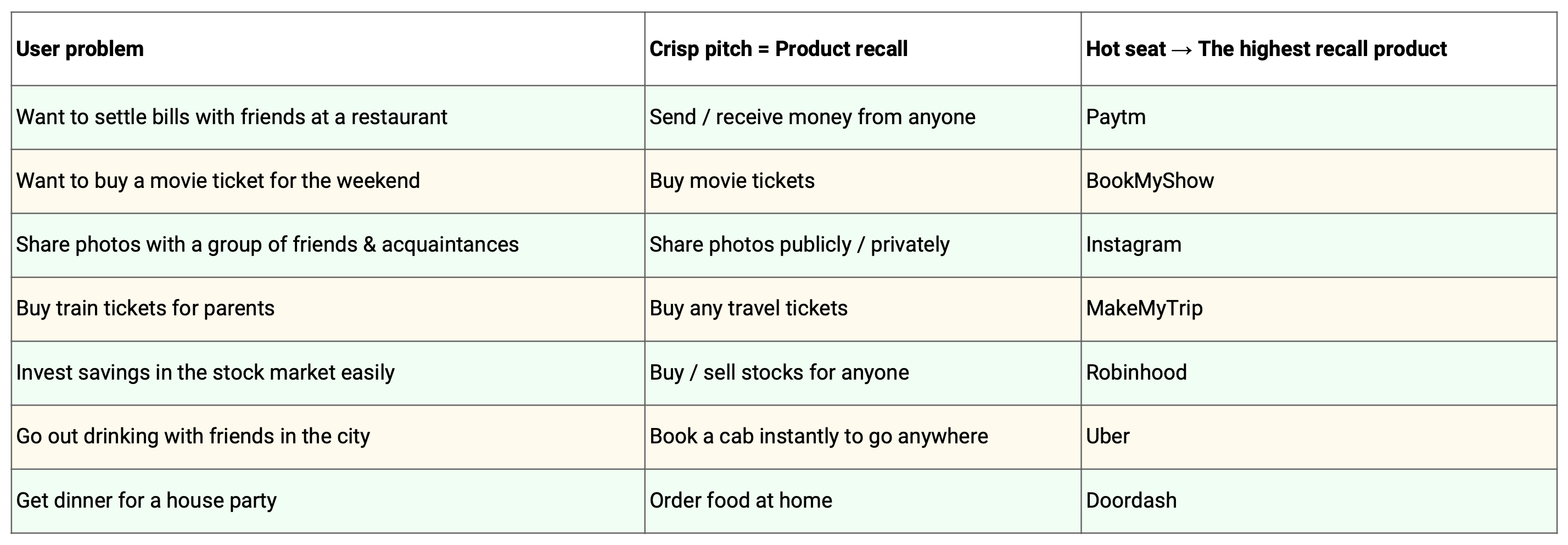Hot Seat Products
The drums of keeping your product focused and crisp have been beaten way too much – so why then, do we see so many products diluted by a mixture of features that feel loosely connected at best?
Without taking names, we all can think of an app that went from doing one thing really well to now having so many actions and a cluttered navigation that demands a few extra seconds in order to go to the right menu.
As products grow larger, teams often struggle to keep them from getting cluttered because of territorial insecurities, growth pressures and a lack of coherent vision. But when you’re building a product from 0 to 1, you have to target a very specific problem with a very specific pitch.
I’ve been developing a thesis that can not only help create a new product but also help evaluate a product’s likelihood of succeeding for a given problem.
Product building thesis
Only a product with a crisp pitch can build a high product recall with the user, leading to your product getting the hot seat.
So the 3 major components of the thesis are:
- 🎤 Product pitch – The initial promise to the user
- 🤔 Product recall – Delivering on the promise to the user
- 👑 Hot seat – Earning a permanent place in user’s life
Let’s look at this thesis in action with some real examples:

When a product has a clear pitch, it has a high likelihood of being instinctively employed by the user to solve their problem.
Let’s understand the 3 thesis components in a bit more detail:
🎤 Product pitch
A crisp pitch is a promise – a promise to solve the user’s problem in a specific context, ideally describable in 10 words or less.
“If you have problem X, our product Y will solve it.”
A good product pitch has 2 key characteristics:
- Clarity
- Brevity
There’s a big advantage of such a pitch: Users can champion your product better to their friends & family if the product pitch is clear & short. With a convoluted and heavy pitch, you lose out on that potential word-of-mouth spread.
Major contributors to a convoluted pitch are a lack of conviction in your product or a lack of thorough understanding of the user’s problem. Such a pitch needs work before you start building the product.
🤔 Product recall
Product recall is the immediacy with which a user employs your product when they have the problem.
“I need to buy 3 movie tickets for the weekend.” → Opens BookMyShow
“I want to buy a TV (I may return it if I don’t like it)” → Opens Amazon
Product recall is a measure of how clearly & tightly the product solves the problem. Building recall takes time. Recall is also strongly correlated with the brand, marketing and customer support.
Think about that time when the Amazon customer support rep helped you return an item no-questions-asked, and now Amazon is your preferred place to shop because of that trust and peace of mind.
Once you build a strong product recall, your product then occupies what we call the hot seat.
👑 Hot Seat
The hot seat is the user’s absolute first product preference for a given problem – the product with the highest recall sits on the hot seat.
The user comes to the hot seat product first when faced with the problem. These hot seat products often become synonymous with the market.
Some interesting dynamics around the hot seat:
- The user’s mental and operational bandwidth is limited and they often don’t give product number 2, 3 and 4 much of a chance (if at all). This is why you want your product in the hot seat.
- Hot seat products are sticky. Users don’t like to change them often.
- Users are more forgiving when hot seat products screw up and are likely to give them more chances.
- Earning the hot seat is a multivariate game. If you are selling a commodity that other competitors also offer, try to differentiate by offering better support, better flexibility and so on.
If there’s a very strong product already occupying the hot seat, it is very difficult to undo that built up product recall. The better strategy at that point may be to change your positioning or look to solve a different problem for a different set of users.
So next time you work at an early-stage startup or are starting one yourself, work on a crisp pitch, aim to build a high recall and then chase the hot seat for that problem.
It sound simple because it is indeed simple. Doing simple things is hard though.